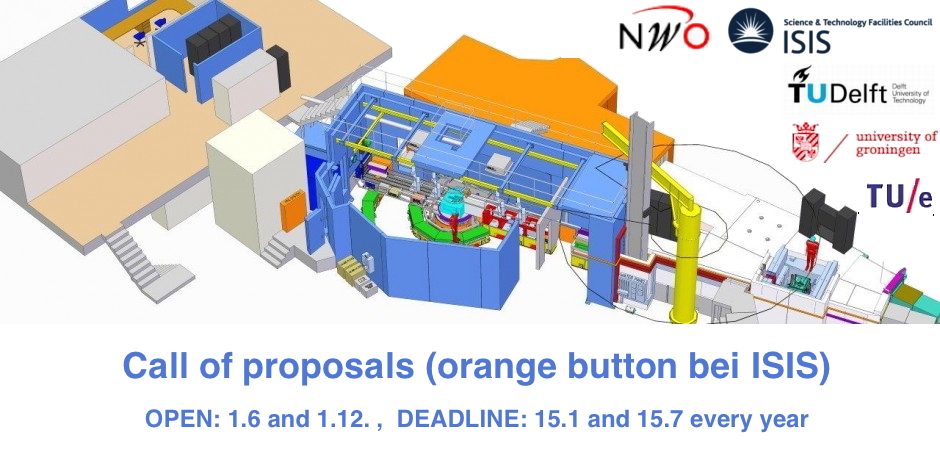- TWITTER !
LARMOR @ ISIS About this blog
LARMOR is a neutron scattering instrument that is now partially financed by a "NWO groot" grant and is been built at the UK neutron source ISIS. The basis is a competitive future proof SANS instrument fully paid, developed and run by ISIS. The Dutch contribution will significantly increase its functionality by exploiting a broad range of Larmor labeling methods in the space and time domain.Categories
- Delft site visit by NWO (1)
- High Resolution Larmor Diffraction (1)
- LARMOR proposal (1)
- Magnetism (5)
- Material science (3)
- MISANS (2)
- N(R)SE (1)
- NEWS (47)
- Polarized SANS (1)
- SANS (1)
- Science case (6)
- SESANS (2)
- Soft Matter (15)
- The Instrument (4)
- TOFLAR (1)
- Why neutrons? (1)
RELATED BLOGS
Archive
- June 2020 (1)
- January 2020 (2)
- October 2019 (1)
- September 2019 (1)
- January 2019 (1)
- December 2018 (1)
- June 2018 (1)
- October 2017 (1)
- September 2017 (1)
- August 2017 (1)
- May 2017 (3)
- July 2016 (1)
- April 2016 (1)
- February 2016 (1)
- December 2015 (2)
- August 2015 (1)
- July 2015 (2)
- June 2015 (2)
- May 2015 (1)
- April 2015 (5)
- March 2015 (1)
- February 2015 (1)
- January 2015 (1)
- November 2014 (2)
- October 2014 (3)
- July 2014 (2)
- April 2014 (1)
- March 2014 (2)
- January 2014 (1)
- December 2013 (2)
- July 2013 (1)
- June 2013 (1)
- May 2013 (1)
- April 2013 (1)
- March 2013 (1)
- February 2013 (1)
- January 2013 (1)
- October 2012 (1)
- September 2012 (1)
- June 2012 (2)
- February 2012 (1)
- November 2011 (8)
- October 2011 (7)
Meta
Author Archives: Jeroen Plomp
Material science
Hybrid organically linked silica is a highly promising class of materials for the application in energy-efficient molecular separation membranes. The materials consist of an amorphous silica matrix in which part of the Si-O-Si bond are replaced by Si-R-Si, where R … Continue reading
Posted in Material science
Leave a comment
Magnetism
In some cases multiferroics can exhibit structural inhomogeneity in the form of domains with subtly different structures. For example, when the prototypical spin-spiral multiferroic TbMnO3 is doped on the Tb-site by a few percent of Ca, the ferroelectricity is gradually … Continue reading
Posted in Magnetism
Leave a comment
Soft matter application
The strength of neutrons in soft matter investigations lies in the direct sensitivity to the relevant time and length scales as well as in the ability to distinguish between hydrogen and deuterium, the so-called contrast variation method. The SANS, SESANS, … Continue reading
Posted in Soft Matter
Leave a comment
The Instrument
LARMOR is one of the four “phase 2” instruments planned to be built at the Second Target Station of the UK spallation source ISIS. The go ahead for these instruments came March 2011, with the allocation of 21M£. LARMOR will … Continue reading
Posted in The Instrument
Leave a comment
Why do we want to use neutrons
Atoms or groups of atoms (molecules) build our world including ourselves. If we want to use the materials around us: liquids, solids, magnets, polymers, proteins, we must know why they behave the way they do, we must understand the way … Continue reading
Posted in Why neutrons?
Leave a comment
MISANS
The Modulated Intensity Small Angle Neutron Scattering option. We modulate the polarization as function of time upstream of the sample. MISANS uses only the resonant flippers in front of the sample, driven at different frequencies, which leads to a high-frequency … Continue reading
Posted in MISANS
Leave a comment
TOFLAR
The Time Of Flight Amplitude Regulation option. An increased resolution can be measured via a Fourier transform. TOFLAR uses only the Larmor labelling elements in front of the sample to modulate the beam as shown in the figure. In this … Continue reading
Posted in TOFLAR
Leave a comment
N(R)SE
The Neutron Resonance Spin-Echo option with magnets moved to 90 degree angle. The accepted scattered beam divergence is low. By replacing the RF magnet systems by a combination of RF flippers and large coils we can increase … Continue reading
Posted in N(R)SE
Leave a comment
High reslolution Larmor diffraction
High resolution Larmor diffraction will use the same components as SESANS but at wide-angle diffraction configuration and with the two precession fields in the same direction, shown in the figure, measuring lattice spacings Δd/d with accuracies as high as high … Continue reading
SESANS
The Spin-Echo Small Angle Neutron Scattering option by insertion of angle labelling magnets. SESANS will have two oppositely oriented precession regions before and after the sample with inclined field boundaries and will resolve scattering angles as small as ~ 10 … Continue reading
Posted in SESANS
Leave a comment
